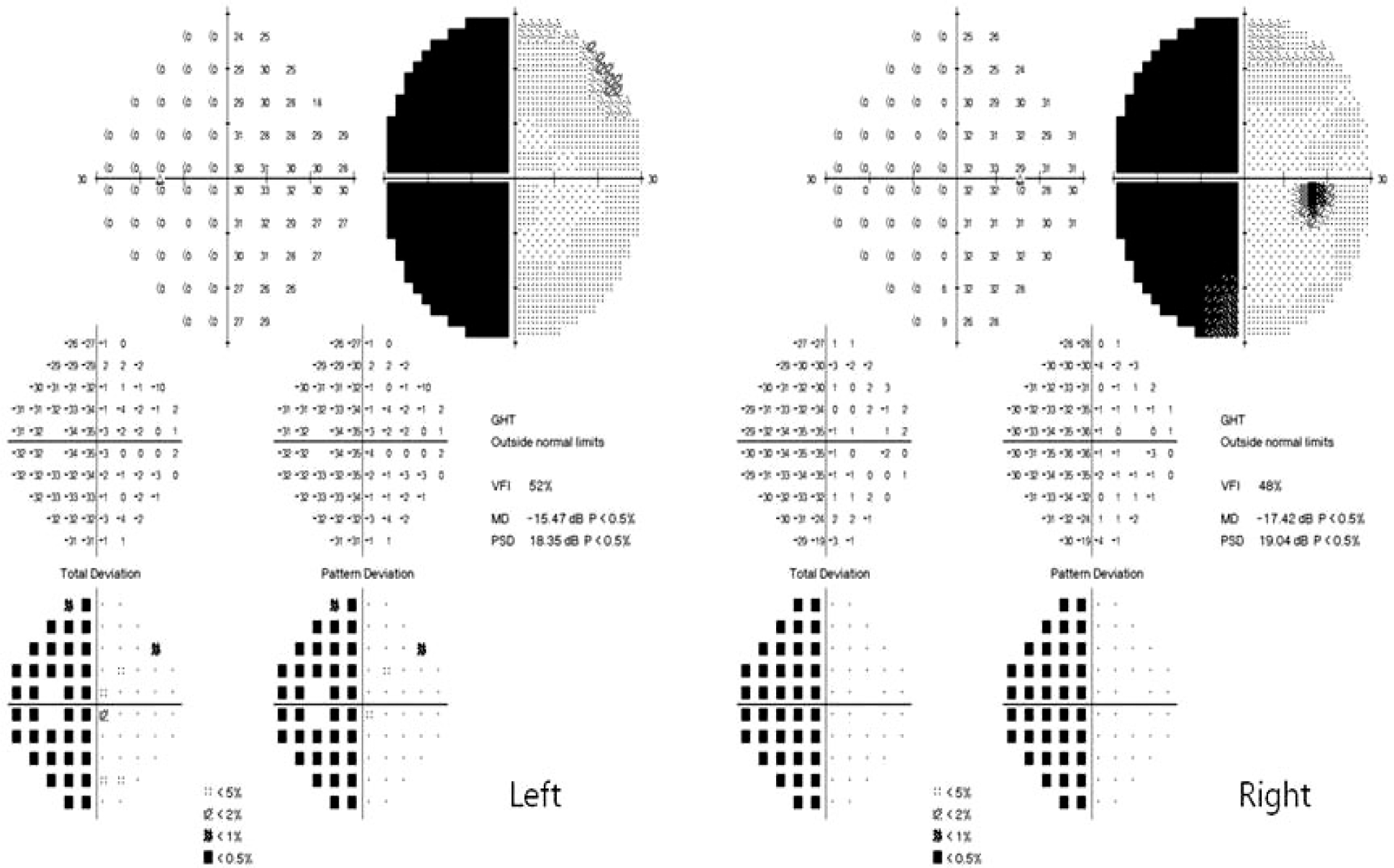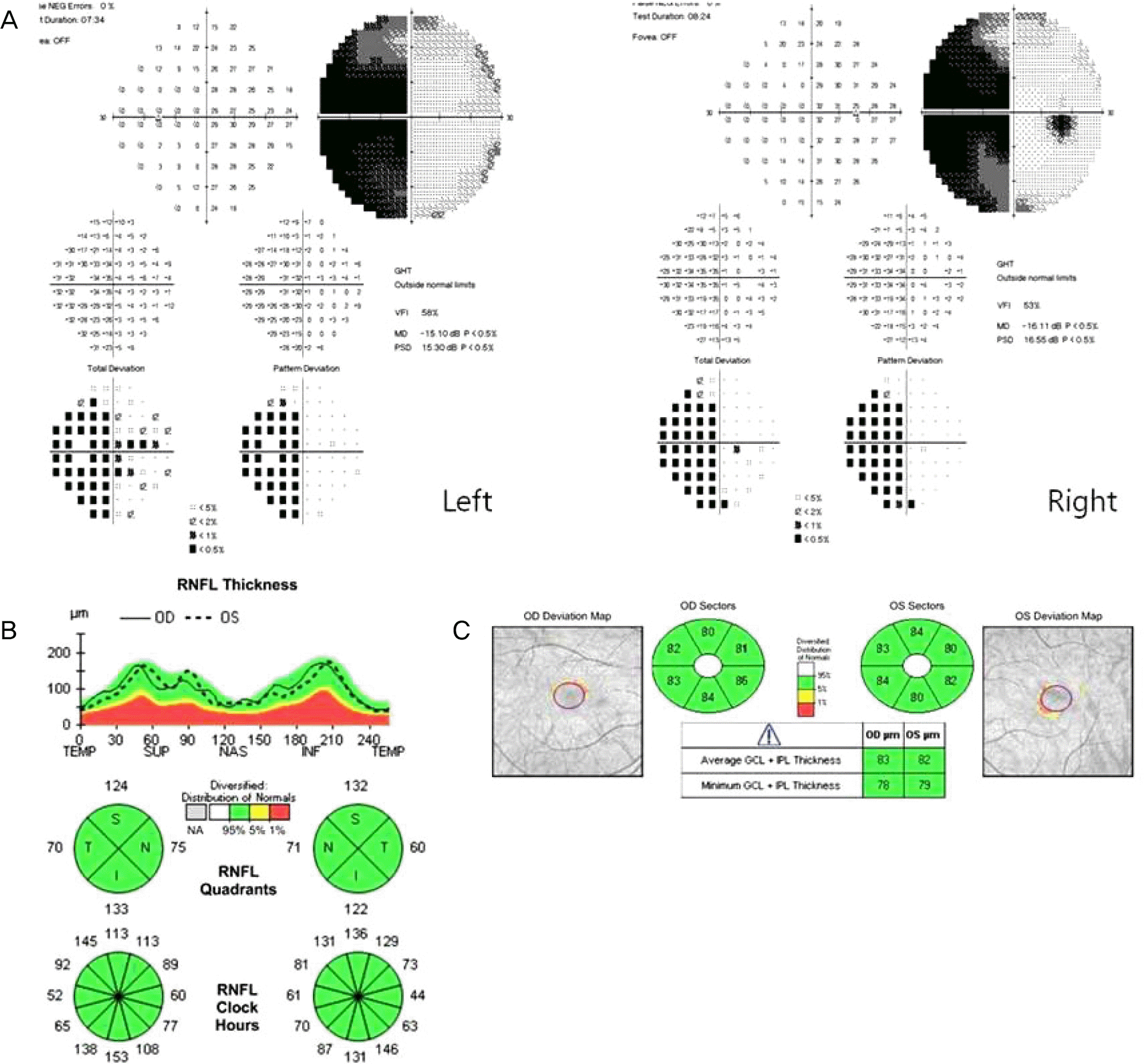Abstract
Case summary
A 51-year-old female with a history of hepatectomy and diagnosis of hepatocellular carcinoma (HCC) 19 months earlier was referred to our neuro-ophthalmology clinic for evaluation due to headache and decreased visual acuity over the past several months. Best visual acuity was 20/20, and the results of all other aspects of our examination were normal except Humphrey automatic perimetry, which showed complete left homonymous hemianopia. Brain magnetic resonance imaging showed a large mass in the right occipital lobe. Craniotomy and removal of tumor were performed. HCC was confirmed by histo-pathologic examination.
Go to : 
References
1. Oh CM, Won YJ, Jung KW. . Cancer statistics in Korea: in-cidence, mortality, survival, and prevalence in 2013. Cancer Res Treat. 2016; 48:436–50.

2. Tsai JF, Jeng JE, Ho MS. . Effect of hepatitis C and B virus in-fection on risk of hepatocellular carcinoma: a prospective study. Br J Cancer. 1997; 76:968–74.

3. Choi HJ, Cho BC, Sohn JH. . Brain metastases from hep-atocellular carcinoma: prognostic factors and outcome: brain meta-stasis from HCC. J Neurooncol. 2009; 91:307–13.
4. Jiang XB, Ke C, Zhang GH. . Brain metastases from hep-atocellular carcinoma: clinical features and prognostic factors. BMC Cancer. 2012; 12:49.

5. Hsu SY, Chang FL, Sheu MM, Tsai RK. . Homonymous hemianopia caused by solitary skull metastasis of hepatocellular carcinoma. J Neuroophthalmol. 2008; 28:51–4.

6. Shim YS, Ahn JY, Cho JH, Lee KS. . Solitary skull metastasis as ini-tial manifestation of hepatocellular carcinoma. World J Surg Oncol. 2008; 6:66.

7. Seinfeld J, Wagner AS, Kleinschmidt-DeMasters BK. . Brain meta-stases from hepatocellular carcinoma in US patients. J Neurooncol. 2006; 76:93–8.

8. Park TY, Na YC, Lee WH. . Treatment options of metastatic brain tumors from hepatocellular carcinoma: surgical resection vs. gamma knife radiosurgery vs. whole brain radiation therapy. Brain Tumor Res Treat. 2013; 1:78–84.
Go to : 
 | Figure 1.Humphrey visual field shows complete left homonymous hemianopia at the initial presentation. Humphrey visual field shows complete left homonymous hemianopia with macular splitting at the initial presentation. |
 | Figure 2.Brain magnetic resonance imaging shows a large mass in the right occipital lobe. A 4.4 × 4.2 × 4.8 cm sized heteroge-neous mass with brain edema was observed in gadolinium enhanced T1- weighted image of axial view (A), in T2-weighted image of axial view (B), and in fluid attenuated T2-weighted sagittal view (C). |
 | Figure 3.Pathologic findings of metastatic brain tumor. (A) Photomicrograph shows polygonal tumor cells arranged in thick trabe-culae and intervening sinusoid-like vascular spaces (Hematoxylin and eosin staining, ×200). (B) Immunohistochemical staining for hepatocyte specific antigen shows diffuse cytoplasmic positivity in tumor cells (×400). |
 | Figure 4.Visual field and optical coherence tomography at one month after tumor resection. (A) Humphrey visual field demonstrates slight resolution of left homonymous hemianopia. (B) Optical coherence tomography shows normal peripapillary retinal nerve fiber layer and (C) ganglion cell- inner plexiform layer thickness. RNFL = retinal nerve fiber layer; OD = oculus dexter; OS = oculus sinis-ter; TEMP = temporal; SUP = superior; NAS = nasal; INF = inferior; S = superior; N = nasal; I = inferior; T = temporal; GCL = ganglion cell layer; IPL = inner plexiform layer. |
 | Figure 5.Postoperative brain magnetic resonance imaging shows total removal of enhancing mass in the right occipital lobe in fluid attenuated T2-weighted axial view. Postoperative brain magnetic resonance imaging shows total removal of enhancing mass in the right occipital lobe in fluid attenuated T2-weighted axial view. Marginal enhancement of the resection cavity suggests reactive change in the occipital lobe. |




 PDF
PDF ePub
ePub Citation
Citation Print
Print


 XML Download
XML Download